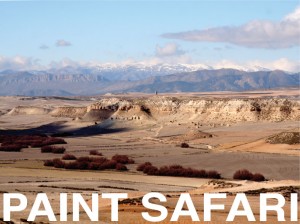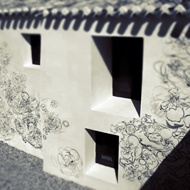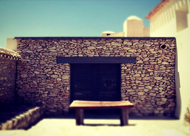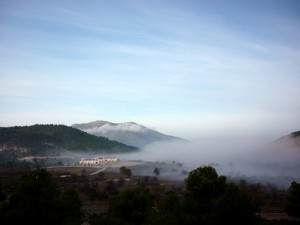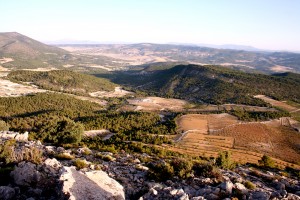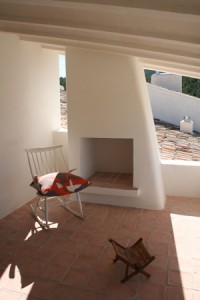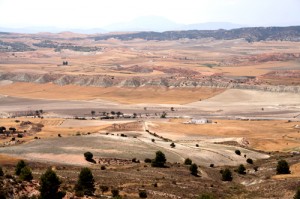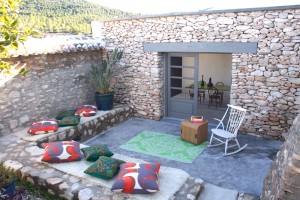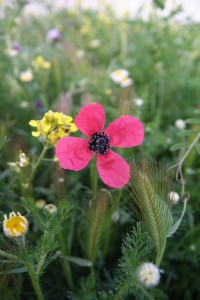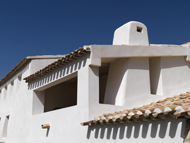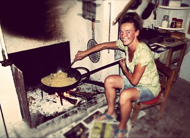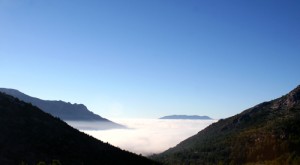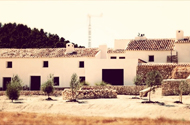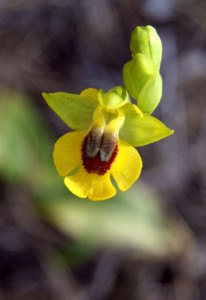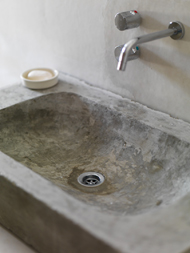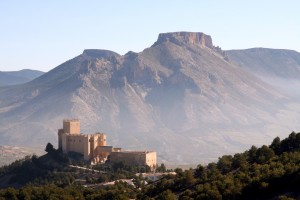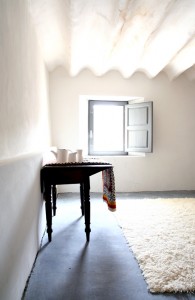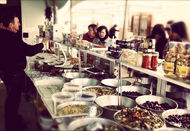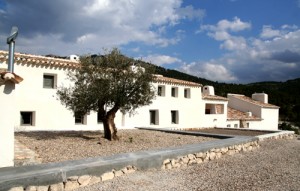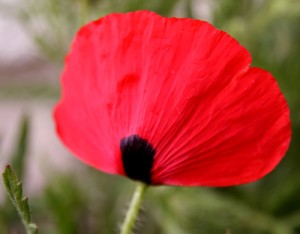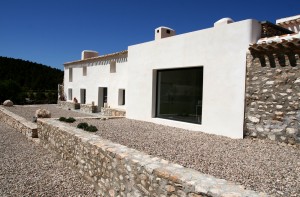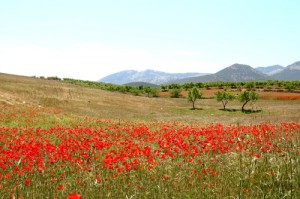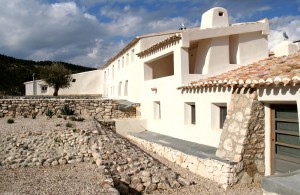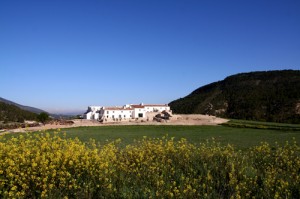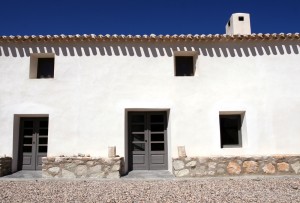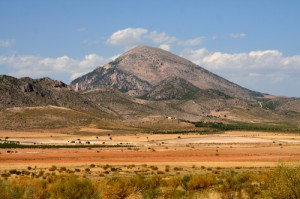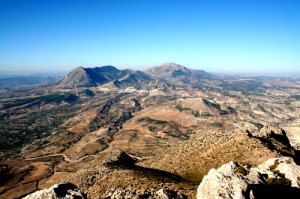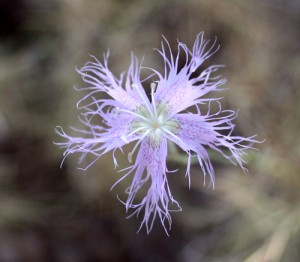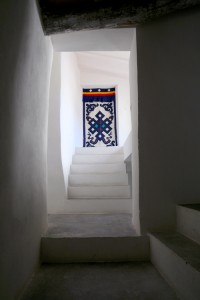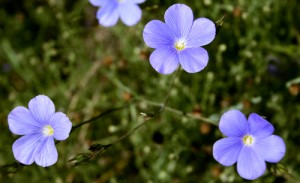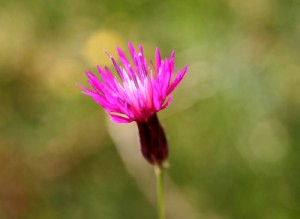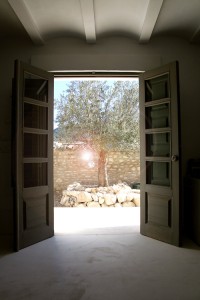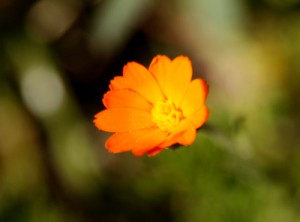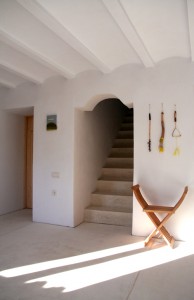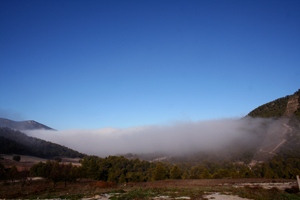January 23, 2014 at 10:43 am
· Filed under Design, ecology systems, Environment
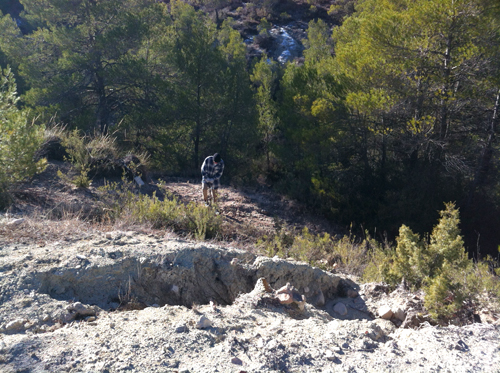
At Los Gázquez and indeed in the whole region, land suffers from erosion. There are many reasons for this and indeed this is a topic for another post. What we are currently concerned with is naturally combating this problem. So this is a trial which I will from time to time post again as an update as to it’s success or failure.
As you can see in the picture above, ’tilled’ land is fragile and can easily start washing away, even in a dry climate like ours. Once ‘fissures’ develop it only takes a small obstacle like a rock to accelerate the problem as it creates a step which amplifies the downward pressure of water on the soil causing greater erosion. One of the problems this land suffers from is the loss of native plant species which would support soils such as ‘esparto grass’…
If one observes what is happening in your location the landscape potentially reveals solutions to problems. This is esparto grass happily growing on a knoll. However the knoll is there because the root system of the grass supports the soil beneath it. The reason the grass is raised is because the soil around it has washed away. Esparto takes around 20 years to recolonise an area. So, how can we reproduce that intricate network of roots rapidly…
Here is an almond tree happily growing above the erosional fissure in question. Every year we have to prune the almonds to keep them productive and accessable. Locally these prunings are burnt however we thought we might make an experiment…
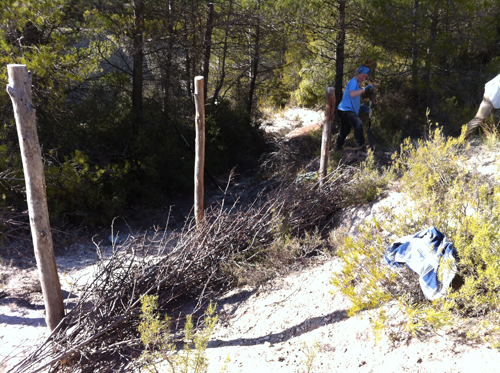
At the base of the erosional fissure we have dug in a series of posts. Behind these posts we are carefully weaving the almond prunings to create a permeable barrier…
It’s not finished yet but the idea is that the network of branches will allow water to pass through but capture soil and small stones and hold onto them the way the esparto grass roots do. In time the deposits of soil will build up and naturally re-build the bank that was previously washing away. What’s more, the almond branches will break down and release organic matter into the soil and help the rejuvenation of plant species like esparto grass etc. It’s an experiment but let’s hope it works.
Thanks must be given to our volunteers Jeroen, Franck and Fannie.
Permalink
January 21, 2014 at 5:51 pm
· Filed under Design, Environment, permaculture, Plantlife
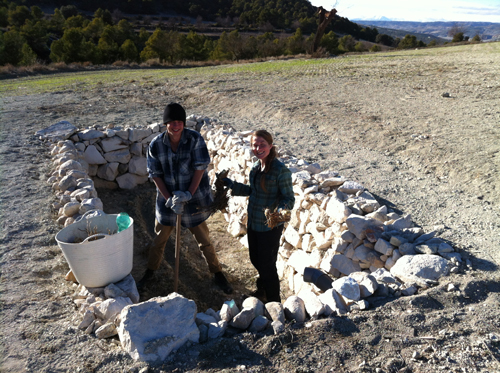
Here is French Franck (actually a Kiwi) and Canadian Fannie, two fab volunteers adding the final touches to our new grey water reed bed. That’s planting the giant cane Arundo Donax.
The weather is beautiful, warm with a cool breeze, ideal for planting…
and in they go. Finished in half an hour. I’ll let you know when they germinate.
Permalink
November 9, 2013 at 2:31 pm
· Filed under Amigos de Los Gázquez, Environment
A good (and hard) days work building the new grey water reclamation system at Los Gázquez. The plan is to make this depression into a reed bed for giant cane Arundo Donax. Once established it can grow 6 to 10 meters high. The reed is actually sterile producing no viable seeds, instead it reproduces asexually via spreading it’s rhizomes underground at it’s base. This is good for us as it can’t spread uncontrollably like some reeds such as Phragmites Australis. The reclamation element for us is the harvesting of the cane for use in construction. As a plant designed for cropping the low tillage rate compared to conventional farming means that there is a high organic content in the soil and in turn the carbon capture is high.
Thank you Andy, Gonzaga and Andrés for the use of your backs.
Permalink
August 31, 2013 at 7:05 pm
· Filed under Environment
We are looking for volunteers to collect and chop wood in the forest for the winter. Please contact us at [email protected]
Se necesitan voluntarios para cortar leña en el bosque para el próximo invierno. Los interesados pueden escribir a [email protected]
Permalink
December 12, 2010 at 1:12 pm
· Filed under Environment
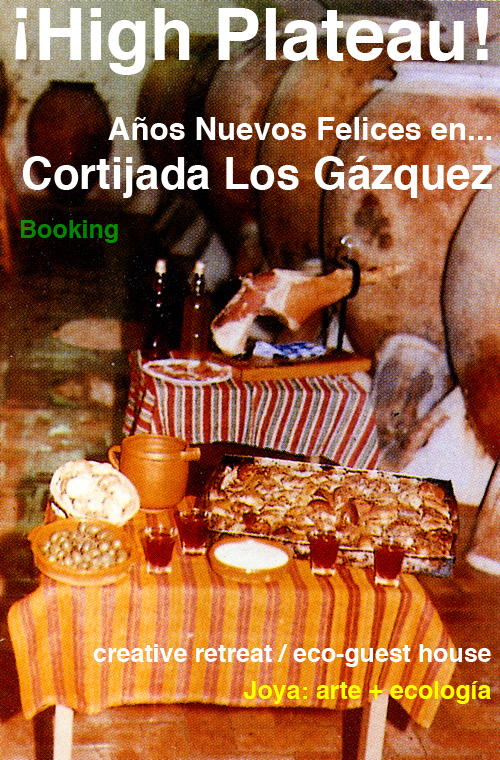
If you haven’t made plans for the New Year yet we would love to see you… contact Simon through here and we can make those plans.
Permalink
July 2, 2010 at 5:31 pm
· Filed under Environment
By complete coincidence I was talking this morning to our friend Vicente about how I had just started reading the story of the Kontiki expedition. To Vicente it’s a book close to his heart as his grandfather read it to him when he was a child back in Argentina. I remember the fantastic romance of science based adventure as I saw it on TV as a child. In fact I was saying to Vicente ‘where is the science based adventure’? And then suddenly today I came across it, I’ll let them speak for themselves via their web-site…
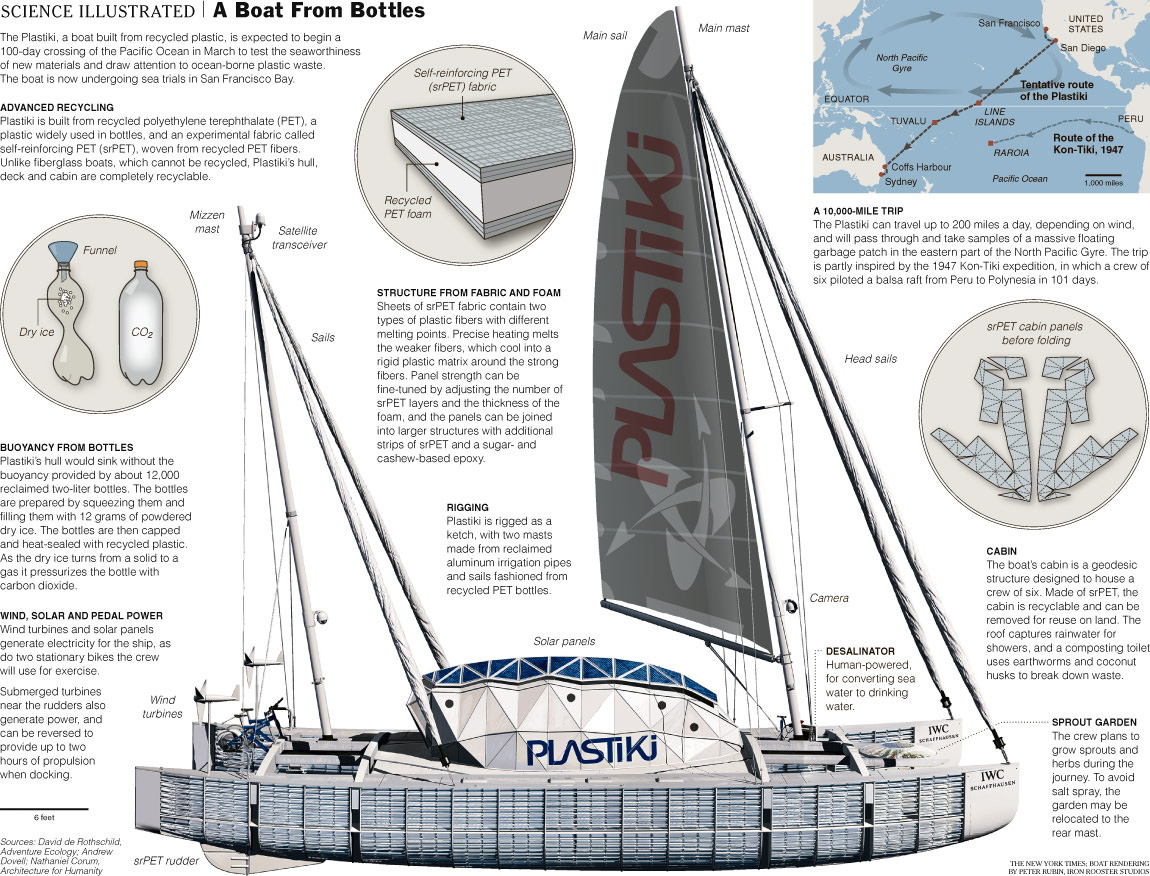
PLASTIKI
Permalink
February 25, 2010 at 4:30 pm
· Filed under Environment

Last night we had a halo around a three quarter waxing gibbous moon and a sight more beautiful than my photo can possibly describe. It appeared to be an enormous hole in a thin layer of alto cirrus cloud, but could the moon generate enough radiation to evaporate this high altitude moisture? We needed the advice of an expert. So I e-mailed Tristan Gooley (see previous post) this morning and asked for advice…
Hi Simon,
Hard to be certain from one photo, but it looks like a similar phenomenon to a ‘moonbow’. Rainbows, fogbows and moonbows are all arcs, often coloured, caused by reflection and refraction of the light from the sun or moon hitting water particles in the atmosphere.
In this case the moisture may be a thin layer of cirrus cloud. The Arctic Innuit and Pacific islanders have been known to use this effect to forecast bad weather, in western terminology, they can herald an approaching front.
I may be completely wrong though!
best, T
Ah, an approaching front. Let’s check the weather forecast…
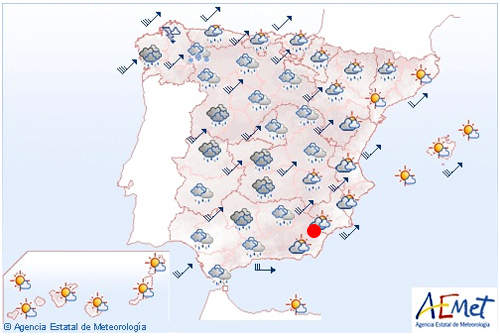
there it is. We are where I have put a red dot. The front is moving to the north of us on a warm south westerly wind. This is often why the east coast of Spain is dry, weather systems seem to move to the north of us held at bay by some Mediterranean high pressure.
Permalink
February 18, 2010 at 7:40 pm
· Filed under Environment


Nice things have been written about us by this couple of cool Californians at ‘A World Different‘. But don’t read my words read theirs. Eco-tourism is as much about building / re-building sustainable communities as it is about having sustainable energy systems etc. Globalisation would be a far more ethical and cohesive concept if it was about the sharing of ethical and ecological ideas and knowledge at grass root levels rather than corporate. These folk champion this dream and should be applauded for their efforts.
Awesome, as they say in California.
Permalink
January 19, 2010 at 4:47 pm
· Filed under Architecture, Design, Environment, Family, Joya
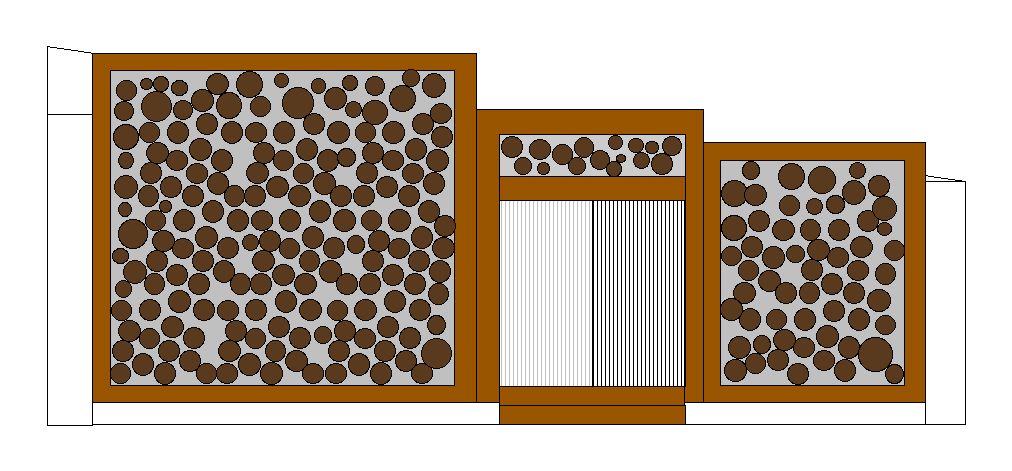
Cortijada Los Gázquez is looking for a volunteer who (either with experience or is just keen and able) would like to volunteer to help out with a green build. Naturally board and lodging is on the house and all they would have to do is get themselves here.
The construction will be a modification to an existing building in order to convert it into a second studio for the Joya residency. The construction will be cordwood and cob built within a post and beam type of construction. All materials will be taken from our land.
Expect the experience to be rewarding and hard work with lots of sunshine and good company.
Permalink
November 29, 2009 at 9:03 am
· Filed under Design, Environment, permaculture
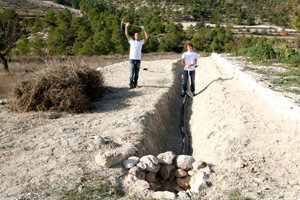 This autumn (even though it hadn’t really arrived until this weekend) has seen us take the opportunity to re-install the grey water system. All the grey water from Los Gázquez leaves the house by it’s own dedicated waste water system. When I say grey water, I mean water from the showers, basins, kitchen sinks, dishwasher and washing machine. What is more we only use ecologically safe detergents as this water is used to irrigate a terrace of fruit trees.
This autumn (even though it hadn’t really arrived until this weekend) has seen us take the opportunity to re-install the grey water system. All the grey water from Los Gázquez leaves the house by it’s own dedicated waste water system. When I say grey water, I mean water from the showers, basins, kitchen sinks, dishwasher and washing machine. What is more we only use ecologically safe detergents as this water is used to irrigate a terrace of fruit trees.
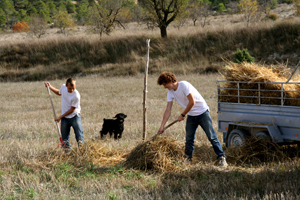 To help us with this task we had two wonderful young French men from Lyon. Lloyd and Romaine were on their gap year and they stayed with us for a few weeks on their return from a month in Morocco. (I have to say that if their parents are reading this we must say that they are a credit to them, they are welcome back here any time). The first thing to do was to dig an horizontal swale or ditch with an access point at one end which you can see in the foreground (below). In the excavation we laid field drain. Next we collect the barley straw from last summer and cut the straw from last springs wild flowers.
To help us with this task we had two wonderful young French men from Lyon. Lloyd and Romaine were on their gap year and they stayed with us for a few weeks on their return from a month in Morocco. (I have to say that if their parents are reading this we must say that they are a credit to them, they are welcome back here any time). The first thing to do was to dig an horizontal swale or ditch with an access point at one end which you can see in the foreground (below). In the excavation we laid field drain. Next we collect the barley straw from last summer and cut the straw from last springs wild flowers.
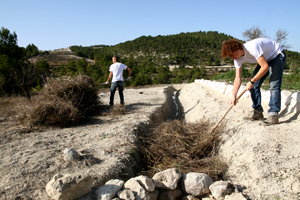 Firstly the wild flower straw goes over the field drain in the ditch. It has more structural integrity so the idea is that it supports the material we put over the top. We have adapted the idea from Permaculture techniques. The swale will hold the water stopping it from running off and giving it time to soak into the earth. When the earth is dry, being clay, it is as hard as concrete making whatever rainfall we have simply run away.
Firstly the wild flower straw goes over the field drain in the ditch. It has more structural integrity so the idea is that it supports the material we put over the top. We have adapted the idea from Permaculture techniques. The swale will hold the water stopping it from running off and giving it time to soak into the earth. When the earth is dry, being clay, it is as hard as concrete making whatever rainfall we have simply run away.
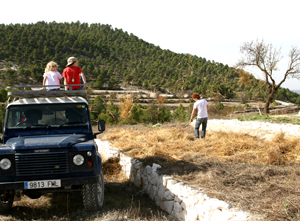 Lastly, with an audience of eight year olds on my car roof, we apply the barley straw. This is laid like a thick blanket over the whole terrace. The idea is that it will act like a sponge keeping the newly introduced grey water high in the earth, watering the tree roots from beneath. It is also a deep mulch keeping the clay earth soft and allowing worms and such to break down this organic matter, conditioning the soil.
Lastly, with an audience of eight year olds on my car roof, we apply the barley straw. This is laid like a thick blanket over the whole terrace. The idea is that it will act like a sponge keeping the newly introduced grey water high in the earth, watering the tree roots from beneath. It is also a deep mulch keeping the clay earth soft and allowing worms and such to break down this organic matter, conditioning the soil.
We have three terraces for this system so we can alternate where the grey water goes, freshly irrigating one terrace while the others rest. What is more it’s entirely organic and can be replenished or removed with ease. Last spring we planted four trees on the first terrace which was fed by the grey water in a canal. This was marginally successful but out of the four trees we planted, pear, persimmon, fig and apricot, the apricot died as I suspect it had too much water. The new system will hopefully combat that problem, Let’s see.
And thanks to Lloyd and Romaine.
Permalink










 This autumn (even though it hadn’t really arrived until this weekend) has seen us take the opportunity to re-install the grey water system. All the grey water from Los Gázquez leaves the house by it’s own dedicated waste water system. When I say grey water, I mean water from the showers, basins, kitchen sinks, dishwasher and washing machine. What is more we only use ecologically safe detergents as this water is used to irrigate a terrace of fruit trees.
This autumn (even though it hadn’t really arrived until this weekend) has seen us take the opportunity to re-install the grey water system. All the grey water from Los Gázquez leaves the house by it’s own dedicated waste water system. When I say grey water, I mean water from the showers, basins, kitchen sinks, dishwasher and washing machine. What is more we only use ecologically safe detergents as this water is used to irrigate a terrace of fruit trees. To help us with this task we had two wonderful young French men from Lyon. Lloyd and Romaine were on their gap year and they stayed with us for a few weeks on their return from a month in Morocco. (I have to say that if their parents are reading this we must say that they are a credit to them, they are welcome back here any time). The first thing to do was to dig an horizontal swale or ditch with an access point at one end which you can see in the foreground (below). In the excavation we laid field drain. Next we collect the barley straw from last summer and cut the straw from last springs wild flowers.
To help us with this task we had two wonderful young French men from Lyon. Lloyd and Romaine were on their gap year and they stayed with us for a few weeks on their return from a month in Morocco. (I have to say that if their parents are reading this we must say that they are a credit to them, they are welcome back here any time). The first thing to do was to dig an horizontal swale or ditch with an access point at one end which you can see in the foreground (below). In the excavation we laid field drain. Next we collect the barley straw from last summer and cut the straw from last springs wild flowers. Firstly the wild flower straw goes over the field drain in the ditch. It has more structural integrity so the idea is that it supports the material we put over the top. We have adapted the idea from Permaculture techniques. The swale will hold the water stopping it from running off and giving it time to soak into the earth. When the earth is dry, being clay, it is as hard as concrete making whatever rainfall we have simply run away.
Firstly the wild flower straw goes over the field drain in the ditch. It has more structural integrity so the idea is that it supports the material we put over the top. We have adapted the idea from Permaculture techniques. The swale will hold the water stopping it from running off and giving it time to soak into the earth. When the earth is dry, being clay, it is as hard as concrete making whatever rainfall we have simply run away. Lastly, with an audience of eight year olds on my car roof, we apply the barley straw. This is laid like a thick blanket over the whole terrace. The idea is that it will act like a sponge keeping the newly introduced grey water high in the earth, watering the tree roots from beneath. It is also a deep mulch keeping the clay earth soft and allowing worms and such to break down this organic matter, conditioning the soil.
Lastly, with an audience of eight year olds on my car roof, we apply the barley straw. This is laid like a thick blanket over the whole terrace. The idea is that it will act like a sponge keeping the newly introduced grey water high in the earth, watering the tree roots from beneath. It is also a deep mulch keeping the clay earth soft and allowing worms and such to break down this organic matter, conditioning the soil.





